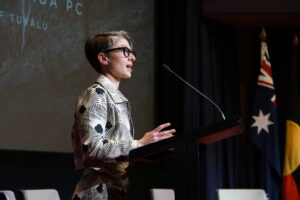Published by RenewEconomy and Sydney Environment Institute.
The US government has announced a US$36 million program to develop technologies that turn solar PV and storage batteries into a new kind of decentralised, virtual power source which some are calling ‘the internet of energy’. This is just the kind of technological shift that excites our new Prime Minister Malcolm and terrified his predecessor, Tony Abbott, the defender of coal.
The solar storage program is part of one of President Obama’s biggest and least reported achievements, the SunShot Initiative. As President Kennedy defined his era with the moonshot, Obama established SunShot to take America from dependence on fossil fuels to clean energy, by making solar PV (and solar thermal with storage) competitive with conventional energy before 2020.
Solar is the internet, coal is the telegraph
The new US18 million in SHINES grants from the US Department of Energy are matched by industry and designed to halve the cost of battery storage paired with solar PV. These projects are practical efforts to make storage the ‘killer app’ that allows solar to beat conventional energy, on price alone.
The R&D will work out how to match storage and solar so it provides stability to the network. When that works, the old centralised ‘baseload’ model of coal power will go the way of the abacus and the telegraph.
Australia’s relationship with the US puts us in pole position to win a big share of this American clean energy boom. With the free trade agreement in place, we have the opportunity to sell renewable energy goods and services to the world’s largest economy.
Prime Minister Malcolm Turnbull has put innovation on the national agenda and after his visit with US President Barack Obama he will be looking to bring back a prize which benefits Australia. A partnership on solar and batteries would tick all of the boxes.
Post Paris World
The Paris climate goals, supported by Australia and the US will accelerate the race between America, China, India, Japan and Germany to be the clean energy superpower, competing in a market worth trillions of dollars. New Bloomberg New Energy Finance data on global energy investment confirms that renewables started to overtake fossil fuels in 2015.
This week the World Economic Forum said that the world is on the brink of a 4th industrial revolution and it will be driven by renewables. The humble battery is the enabler the world needs to balance fluctuating generation from solar, wind and other renewables.
The Battery Boom
The Economist recognised this potential when it recently declared the ‘battery is the technology of our time’.
Australia has leading storage start-ups that we should help win a place in the trillion dollar global clean energy market. Companies such as Redflow and Reposit are at the cutting edge.
The US has the most ambitious plans for grid connected energy storage. Australia is the leading distributed solar nation. The marriage seems almost too obvious.
Australia’s grid planning agency, the Australian Energy Market Operator has already modelled a scenario in which 40% of Australian homes install battery storage by 2035. Coal truly is yesterday’s technology.
Rooftops Ready
Australia is a leader in distributed solar. Over 1.5 million households have PV systems. According to the Australian Energy Storage Alliance, that’s more than any other country.
This residential solar plus storage revolution is starting now precisely because we have no national strategy to properly manage it. Rather, solar and storage consumers are being threatened with punitive ‘solar taxes’ which will encourage many to ‘defect’ from the grid. This means they will disconnect from the electricity network and install storage that is big enough to store all their night time energy needs so they can rely on their own solar power 24/7.
Solar households on premium feed in tariffs will lose generous energy export payments during this 2016 election year. It is a political time bomb. That loss of income will push many more to buy storage and defect from the grid. With less users to pay for the massive, $130 billion that Australia is mis-investing in ‘gold plating’ of networks, the users who remain will pay higher bills. Rather than become an accidental leader in storage, we need a coordinated, non-partisan plan.
The tipping point when wind became cheaper than new coal in Australia came faster than anyone predicted. The solar and battery revolution is fast on its heels.
At the Paris climate conference, PM Turnbull committed the government to double clean energy R&D within five years, as part of the Mission Innovation project, launched with the US and 18 other governments. Storage should be a core part of our new funding as part of this international project.
The transformation of the energy sector from fossil fuels to decentralised renewables and storage is a poster-child for ‘creative destruction’. It will certainly ruffle the feathers of the protected species that is the Australian coal sector. But if Malcolm Turnbull gets right behind Barack Obama’s SunShot Initiative and supports battery innovation, Australia could begin to regain its place in the global energy market of the 21st century.
Related documents
Between the Lines Newsletter
The biggest stories and the best analysis from the team at the Australia Institute, delivered to your inbox every fortnight.
You might also like
Why are gas companies trying to sell us hydrogen?
The hydrogen dream has become widespread in the Australian climate conversation: apparently, with it, we’re going to decarbonise Japan, Korea, and the world! Is this ambitious vision a genuine step towards a greener future or merely a diversion from ongoing fossil fuel expansion?
The Climate Crisis is an Integrity Crisis | Polly Hemming
I am starting my address to this year’s summit in the exact same way that I started last year’s address. Because it is just over a year since I delivered these same words, which aren’t actually my words. They are the words of our Climate Change Minister, and they provide a baseline of sorts for what progress has been made in that time.
Labor’s pledge to depoliticise the public service is undermined by the government only hearing what it wants to hear on climate change
While last year’s robodebt royal commission exposed a shocking lack of ethics among senior ranks of the Australian public service, the systemic condition still largely seems to be regarded as an aberration.


